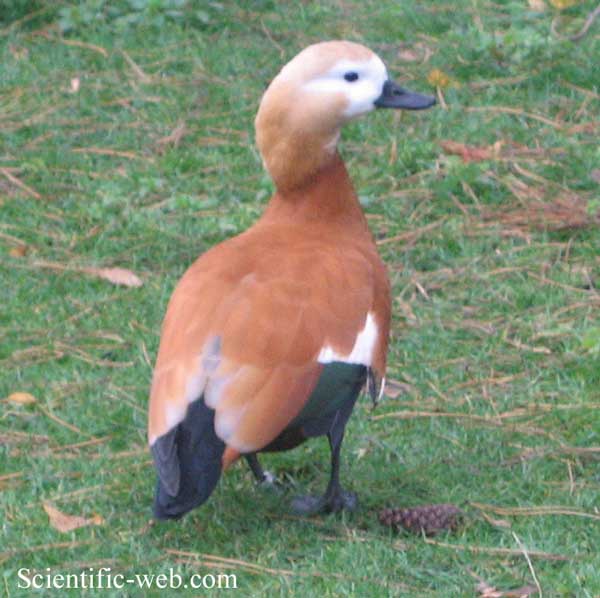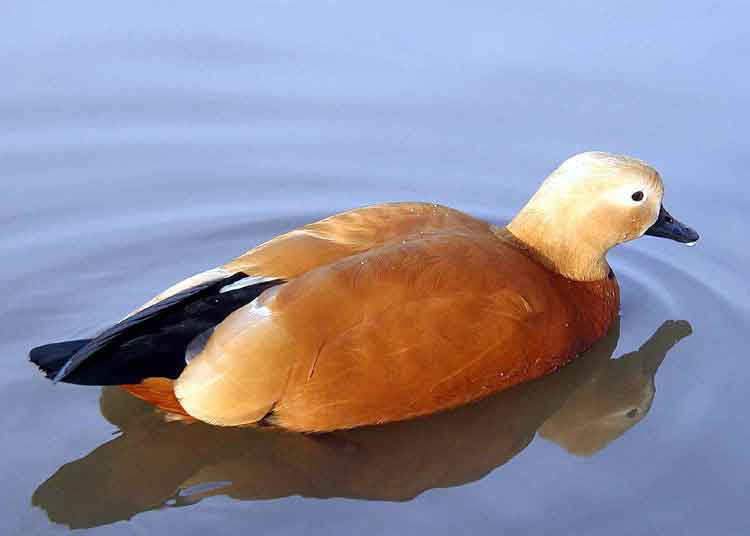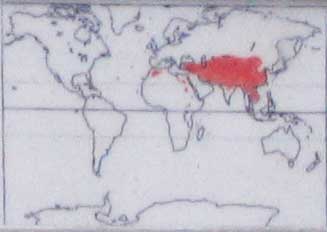
Tadorna ferruginea, Photo: Michael Lahanas
Superregnum: Eukaryota
Cladus: Unikonta
Cladus: Opisthokonta
Cladus: Holozoa
Regnum: Animalia
Subregnum: Eumetazoa
Cladus: Bilateria
Cladus: Nephrozoa
Superphylum: Deuterostomia
Phylum: Chordata
Subphylum: Vertebrata
Infraphylum: Gnathostomata
Megaclassis: Osteichthyes
Cladus: Sarcopterygii
Cladus: Rhipidistia
Cladus: Tetrapodomorpha
Cladus: Eotetrapodiformes
Cladus: Elpistostegalia
Superclassis: Tetrapoda
Cladus: Reptiliomorpha
Cladus: Amniota
Classis: Reptilia
Cladus: Eureptilia
Cladus: Romeriida
Subclassis: Diapsida
Cladus: Sauria
Infraclassis: Archosauromorpha
Cladus: Crurotarsi
Divisio: Archosauria
Cladus: Avemetatarsalia
Cladus: Ornithodira
Subtaxon: Dinosauromorpha
Cladus: Dinosauriformes
Cladus: Dracohors
Cladus: Dinosauria
Ordo: Saurischia
Cladus: Eusaurischia
Subordo: Theropoda
Cladus: Neotheropoda
Cladus: Averostra
Cladus: Tetanurae
Cladus: Avetheropoda
Cladus: Coelurosauria
Cladus: Tyrannoraptora
Cladus: Maniraptoromorpha
Cladus: Maniraptoriformes
Cladus: Maniraptora
Cladus: Pennaraptora
Cladus: Paraves
Cladus: Eumaniraptora
Cladus: Avialae
Infraclassis: Aves
Cladus: Euavialae
Cladus: Avebrevicauda
Cladus: Pygostylia
Cladus: Ornithothoraces
Cladus: Ornithuromorpha
Cladus: Carinatae
Parvclassis: Neornithes
Cohors: Neognathae
Cladus: Pangalloanserae
Cladus: Galloanseres
Ordo: Anseriformes
Familia: Anatidae
Subfamilia: Tadorninae
Genus: Tadorna
Species: Tadorna ferruginea
Name
Tadorna ferruginea (Pallas, 1764)
Synonyms
Anas ferruginea (protonym)
References
Catalogue raisonné d'une collection supérieurement belle d'oiseaux [Vroeg]: 5, no.258 [reprint 1905].

Tadorna ferruginea (*)

Vernacular names
العربية: بط أبو فروة
অসমীয়া: চাকৈ-চকোৱা
azərbaycanca: Qırmızı anqut
башҡортса: Ҡыҙыл өйрәк
беларуская: Агар
български: Червен ангъч
বাংলা: চখাচখি
brezhoneg: Tadorn rous
català: Ànec canyella
čeština: Husice rezavá
Cymraeg: Hwyaden goch yr eithin
dansk: Rustand
Deutsch: Rostgans
Ελληνικά: Καστανόπαπια
English: Ruddy Shelduck
Esperanto: Rusta tadorno
español: Tarro canelo
eesti: Tulipart
euskara: Paita gorrizta
فارسی: آنقوت
suomi: Ruostesorsa
føroyskt: Royðuont
français: Tadorne casarca
Gaeilge: Seil-lacha Rua
galego: Pato canelo
עברית: קזרקה חלודית
हिन्दी: चकवा
hrvatski: Zlatokrila utva
magyar: Vörös ásólúd
հայերեն: Կարմիր բադ
íslenska: Ryðönd
italiano: Casarca
日本語: アカツクシガモ
ქართული: წითელი იხვი
қазақша: Қызыл үйрек
ಕನ್ನಡ: ಚಕ್ರವಾಕ
한국어: 황오리
кыргызча: Аңыр
lietuvių: Rudoji antis
latviešu: Rudā dižpīle
македонски: Лисеста гусковидна патка
മലയാളം: ചക്രവാകം
монгол: Хондон ангир
кырык мары: Якшарлыды
मराठी: चक्रवाक
Malti: Kuluvert Aħmar
Plattdüütsch: Rostgoos
नेपाली: चखेवा
Nederlands: Casarca
norsk: Rustand
ଓଡ଼ିଆ: ପଣ୍ଡା ହଂସ
ਪੰਜਾਬੀ: ਸੁਰਖ਼ਾਬ
polski: Kazarka rdzawa
پنجابی: سرخاب
português: Pato-ferrugíneo
rumantsch: Auca cotschna
русский: Огарь
саха тыла: Кугас кус
slovenčina: Kazarka hrdzavá
slovenščina: Rjasta kozarka
shqip: Kuqaloshja
српски / srpski: Zlatokrila utva - Златокрила утва
svenska: Rostand
தமிழ்: சிவப்புத்தாரா
తెలుగు: చక్రవాకము
ไทย: เป็ดพม่า
Türkçe: Angut
українська: Огар
اردو: سرخاب
oʻzbekcha/ўзбекча: Angʻirt
Tiếng Việt: Vịt vàng
中文: 赤麻鸭
The ruddy shelduck (Tadorna ferruginea), known in India as the Brahminy duck, is a member of the family Anatidae. It is a distinctive waterfowl, 58 to 70 cm (23 to 28 in) in length with a wingspan of 110 to 135 cm (43 to 53 in). It has orange-brown body plumage with a paler head, while the tail and the flight feathers in the wings are black, contrasting with the white wing-coverts. It is a migratory bird, wintering in the Indian subcontinent and breeding in southeastern Europe and central Asia, though there are small resident populations in North Africa. It has a loud honking call.
The ruddy shelduck mostly inhabits inland water-bodies such as lakes, reservoirs and rivers. The male and female form a lasting pair bond and the nest may be well away from water, in a crevice or hole in a cliff, tree or similar site. A clutch of about eight eggs is laid and is incubated solely by the female for about four weeks. The young are cared for by both parents and fledge about eight weeks after hatching.
In central and eastern Asia, populations are steady or rising, but in Europe they are generally in decline. Altogether, the birds have a wide range and large total population, and the International Union for Conservation of Nature has assessed their conservation status as being of least concern.
Taxonomy
Ruddy Shelduck
At Chilika lake, Mangalajodi, Odisha, India
The ruddy shelduck (Tadorna ferruginea) is a member of the shelduck genus Tadorna; in the wildfowl family Anatidae. The bird was first described in 1764 by the German zoologist and botanist Peter Simon Pallas who named it Anas ferruginea, but later it was transferred to the genus Tadorna with the other shelducks.[2][3][4] Some authorities place it in the genus Casarca along with the South African shelduck (T. cana), the Australian shelduck (T. tadornoides) and the Paradise shelduck (T. variegata). Phylogenetic analysis shows that it is most closely related to the South African shelduck. In captivity, the ruddy shelduck has been known to hybridise with several other members of Tadorna, with several members of the dabbling duck genus Anas, and with the Egyptian goose (Alopochen aegyptiaca). No subspecies are recognised.[5]
The genus name Tadorna comes from the French "tadorne", the common shelduck,[6] and may originally derive from a Celtic word meaning "pied waterfowl". The English name "sheld duck" dates from around 1700 and means the same.[7] The species name ferruginea is Latin for "rusty" and refers to the colour of the plumage.[8]
Description
The ruddy shelduck grows to a length of 58 to 70 cm (23 to 28 in) and has a 110–135 cm (43–53 in) wingspan. The male has orange-brown body plumage and a paler, orange-brown head and neck, separated from the body by a narrow black collar. The rump, flight feathers, tail-coverts and tail feathers are black and there are iridescent green speculum feathers on the inner surfaces of the wings. Both upper and lower wing-coverts are white, this feature being particularly noticeable in flight but hardly visible when the bird is at rest. The bill is black and the legs are dark grey. The female is similar but has a rather pale, whitish head and neck and lacks the black collar, and in both sexes, the colouring is variable and fades as the feathers age. The birds moult at the end of the breeding season and the male loses the black collar, but a further partial moult between December and April restores it. Juveniles are similar to the female but are a darker shade of brown.[9]
The call is a series of loud, nasal honking notes, it being possible to discern the difference between those produced by the male and the female. The calls are made both on the ground and in the air, and the sounds are variable according to the circumstances in which they are uttered.[9]
Distribution and habitat
There are very small resident populations of this species in north west Africa and Ethiopia, but the main breeding area of the bird is from southeast Europe across the Palearctic to Lake Baikal, Mongolia, and western China.[10] Eastern populations are mostly migratory, wintering in the Indian subcontinent.[11] This species has colonised the island of Fuerteventura in the Canary Islands, first breeding there in 1994, and reaching a population of almost fifty pairs by 2008.[12] The ruddy shelduck is a common winter visitor in India where it arrives by October and departs by April. Its typical breeding habitat is large wetlands and rivers with mud flats and shingle banks, and it is found in large numbers on lakes and reservoirs. It breeds in high altitude lakes and swamps in Jammu and Kashmir.[11] Outside the breeding season it prefers lowland streams, sluggish rivers, ponds, flooded grassland, marshes and brackish lagoons.[13]
Although becoming quite rare in southeast Europe and southern Spain, the ruddy shelduck is still common across much of its Asian range. It may be this population which gives rise to vagrants as far west as Iceland, Great Britain and Ireland. However, since the European population is declining, it is likely that most occurrences in western Europe in recent decades are escapes or feral birds. Although this bird is observed in the wild from time to time in eastern North America, no evidence has been found that this is a genuine case of vagrancy.[1] Feral ruddy shelduck have bred successfully in several European countries. In Switzerland the ruddy shelduck is considered an invasive species that threatens to displace native birds. Despite actions taken to reduce numbers, the population of ruddy shelduck in Switzerland increased from 211 to 1250 individuals in the period from 2006 to 2016.[14]
A stable population exists in Moscow, settling the city parks' ponds alongside the endemic mallards. It is theorized that the birds are feral descendants of escapees from the Moscow Zoo, the population most likely forming after 1948, when the policy of clipping the birds' wings was repealed. Unlike the wild population, these ducks are non-migratory, wintering instead in the non-freezing parts of the city's bodies of water.[15]
This shelduck mostly frequents open locations on inland bodies of water such as lakes, reservoirs and rivers. It is seldom seen in forested areas but does occur in brackish water and saline lagoons. Though more common in the lowlands, it also inhabits higher altitudes and in central Asia is one of the few waterbirds, along with the bar-headed goose (Anser indicus), to be found on lakes at 5,000 m (16,400 ft).[7]
Behaviour
Ruddy Shelduck flying over the lake
The ruddy shelduck is a mainly nocturnal bird.[13] It is omnivorous and feeds on grasses, the young shoots of plants, grain and water plants as well as both aquatic and terrestrial invertebrates. On land it grazes on the foliage, in the water it dabbles in the shallows, and at greater depths, it up-ends, but it does not dive.[7]
The ruddy shelduck is usually found in pairs or small groups and rarely forms large flocks. However, moulting and wintering gatherings on chosen lakes or slow rivers can be very large. Gatherings of over four thousand birds have been recorded on the Koshi Barrage and in the Koshi Tappu Wildlife Reserve in Nepal, and over ten thousand at Lake Gölü in Turkey.[7]
The birds arrive at their main breeding locations in central Asia in March and April. There is a strong pair bond between the male and female and it is thought they pair for life. In their breeding quarters, the birds are very aggressive towards their own kind and towards other species. The female in particular approaches intruders with head lowered and neck outstretched, uttering anger calls. If the intruder stands its ground, the female returns to the male and runs round him, inciting him to attack. He may or may not do so.[9] Mating takes place on the water after a brief courtship ritual involving neck stretching, head dipping and tail raising.[7] The nesting site is often far away from water in a hole in a tree or ruined building, a crevice in a cliff, among sand-dunes or in an animal burrow. The nest is constructed by the female using feathers and down and some grasses.[9]
A clutch of about eight eggs (range six to twelve) is laid between late April and early June. These have a dull gloss and are creamy-white, averaging 68 by 47 mm (2.68 by 1.85 in). Incubation is done by the female while the male stands in attendance nearby. The eggs hatch after about twenty-eight days and both parents care for the young, which fledge in a further fifty-five days.[7] After breeding the adults moult, losing the power of flight for about a month while they do so. Before moulting they move to large water bodies where they can more easily avoid predation while they are flightless.[13] The family may stay together as a group for some time; the autumn migration starts around September and the young may mature in their second year. North African birds breed about five weeks earlier, and their breeding success is greater in wet summers.[7]
Status
Buddhists regard the ruddy shelduck as sacred and this gives the birds some protection in central and eastern Asia, where the population is thought to be steady or even rising. The Pembo Black-necked Crane Reserve in Tibet is an important wintering area for ruddy shelducks, and here they receive protection. In Europe on the other hand, populations are generally declining as wetlands are drained and the birds are hunted. However, they are less vulnerable than some other waterfowl because of their adaptability to new habitats such as reservoirs.[7]
The ruddy shelduck has a very wide range and an estimated total population size of 170,000 to 225,000 individuals. The overall population trend is unclear as some local populations are increasing while others are decreasing. The bird does not appear to meet the higher criteria necessary to be considered threatened, and the International Union for Conservation of Nature assesses that its conservation status is of least concern.[1] It is one of the species to which the Agreement on the Conservation of African-Eurasian Migratory Waterbirds (AEWA) applies.[16]
References
BirdLife International (2016). "Tadorna ferruginea". IUCN Red List of Threatened Species. 2016: e.T22680003A86011049. doi:10.2305/IUCN.UK.2016-3.RLTS.T22680003A86011049.en. Retrieved 12 November 2021.
Mayr, Ernst; Cottrell, G. William (1979). Check-list of Birds of the World. Vol. 1 (2nd ed.). Cambridge, Massachusetts: Museum of Comparative Zoology. p. 450.
Sherborn, C. Davies (1905). "The new species of birds in Vroeg's catalogue, 1764". Smithsonian Miscellaneous Collections. 47: 332–341 [339 No. 258]. Includes a transcript of the 1764 text.
Rookmaaker, L.C.; Pieters, F.F.J.M. (2000). "Birds in the sales catalogue of Adriaan Vroeg (1764) described by Pallas and Vosmaer". Contributions to Zoology. 69 (4): 271–277. doi:10.1163/18759866-06904005.
Carboneras, C.; Kirwan, G.M. (2014). "Ruddy Shelduck (Tadorna ferruginea)". Handbook of the Birds of the World Alive. Lynx Edicions, Barcelona. Retrieved 20 October 2015.
Jobling, James A (2010). The Helm Dictionary of Scientific Bird Names. London: Christopher Helm. p. 377. ISBN 978-1-4081-2501-4.
Kear, Janet (2005). Ducks, Geese and Swans: General chapters, species accounts (Anhima to Salvadorina). Oxford University Press. pp. 420–430. ISBN 978-0-19-861008-3.
Jobling, James A (2010). The Helm Dictionary of Scientific Bird Names. London: Christopher Helm. p. 159. ISBN 978-1-4081-2501-4.
Witherby, H. F., ed. (1943). Handbook of British Birds, Volume 3: Hawks to Ducks. H. F. and G. Witherby Ltd. pp. 227–231.
Bouglouan, Nicole. "Ruddy Shelduck: Tadorna ferruginea". oiseaux-birds.com. Retrieved 21 October 2015.
Stockley, C.H. (1923). "Some notes on Indian game birds". The Journal of the Bombay Natural History Society. 29: 278–279.
Garcia del Rey, Eduardo; Rodriguez-Lorenzo, Juan Antonio (2010). "Breeding status of the Ruddy Shelduck Tadorna ferruginea at Fuerteventura, Canary Islands: natural colonisation of two habitat types on an oceanic island". Ostrich. 81 (2): 93–96. doi:10.2989/00306525.2010.488376. S2CID 84867588.
"Ruddy Shelduck: Tadorna ferruginea". BirdLife International. 2015. Retrieved 24 October 2015.
Müller, Werner (2 April 2017). "Rechtzeitig handeln". Ornis: 12–14. Archived from the original on 22 September 2018. Retrieved 24 June 2017.
Vishnevsky, Vasily (1 February 2009). "«Оранжевая революция» на московских прудах" [«Orange revolution» in Moscow's ponds]. Наука и Жизнь (in Russian): 141–144. Retrieved 26 June 2022.
"AEWA Species". Agreement on the Conservation of African-Eurasian Migratory Waterbirds. Retrieved 22 October 2015.
Retrieved from "http://en.wikipedia.org/"
All text is available under the terms of the GNU Free Documentation License

